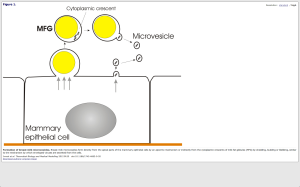Here, let me digest this article for you. Breastmilk could be a medicine.
This is a review of the research done to understand what is actually IN breastmilk and whether breastfeeding can be used as a way to treat some genetic disorders. Some vocabulary before we begin:
- neonate=baby
- genome=the whole of your genetic code; term used to describe individuals’ or species’ genetic information (“human genome”, “Tasha’s genome”)
- cDNA vs DNA vs RNA: DNA is the genetic information in your cells, specifically the nucleus. In general, DNA is the instructions for the cell to make RNA, which acts as a messenger to tell the cell to make proteins. Proteins are what do a lot of the things in the cell. **This is not always the case and if you talk to anyone in science, they cringe when I say that. I’d love to explain further if you ask.** In the lab, you can take the RNA and create the corresponding DNA (almost like going from a translation back to English). This corresponding DNA is called cDNA or “complementary DNA”. This technique is useful when you are trying to identify which genes are being turned on in a tumor or other sample. Simplistically, the cDNA will only contain “ON” genes specific to that sample.
The background information: In the 70s it was noted that some characteristics of a type of virus (retroviruses) were present in breastmilk and researchers tried to figure out why. This type of virus commonly inserts genetic information into the host genome. They concluded that there was not any non-human DNA in the human breastmilk and because some retroviruses cause cancer, they looked for a link. By the 80s, it was clear there was no a link between breastmilk contents and breast cancer. They concluded:
An explanation for this discrepancy could be that those retrovirus-like particles were not virions, but some other kind of particle.
New research: It turns out the particles that were being described as “retrovirus-like” are actually a type of microvesicle. Vesicles are really cool! You can think of vesicles as similar to bubbles. When you dip the bubble wand into the solution and blow, you’re making a spherical bubble that starts out as a teardrop shape and it’s squeezed out into the sphere shape and then detaches. In a way, that’s what a vesicle is. Generic vesicles (Bio101 level info) start our as part of the cell membrane. Something encounters the cell at the membrane and the membrane curves in to make a pit, then closes and gets pinched off to make a “bubble” with the “something” from outside of the cell. Now the cell has a continuous membrane with a vesicle carrying something into the cell.
Back to the paper: So, microvesicles in breastmilk seem to be carrying RNA and other enzymes along with nutrition and healthy fats. Check out the figure they publish as fig 1.

Milk fat globules are triacylglycerol carriers of about 4 micrometer diameter secreted by the mammary epithelial cells and are the main source of energy for the infant. Milk fat globules arise by the fusion of lipid droplets and are thus enveloped in a monolayer from the cytoplasmic leaflet of the endoplasmic reticulum (ER) membrane and are transported to the cell surface where they are pinched off into the alveolar space entirely surrounded in a layer of plasma membrane. Variable amounts of cytoplasm are often entrained between the inner monolayer and the outer bilayer (Figure 1).
VERY cool indeed. In addition, the specific proteins in breastmilk were found to be important for cell processes like cell signaling and other immune system-related processes.
One of the more interesting directions of the review concerns the transmission of viral proteins and infectious virus-spread disease. Nearly a third of all transmissions of HIV from mother to baby occurs via breastfeeding (statistics from this paper) and this review makes the point that a lot of this infection is probably because the viruses that are transmitted to the baby’s gut via breastmilk are easily uncoated by the low pH in the gut. Since the newborn’s gut is more permeable (hence the phrase virgin gut) than older infants, viruses and microvesicles pass into the bloodstream easily. I would venture this is why breastmilk is so easily digested, that it’s the microvesicles and simple molecules that can go directly to work while the “stuff” in formula is hard to digest for newborns and infants.
One of the things I didn’t think about but totally makes sense is the mom is transferring IgG (the major antibody type in the immune system) in breastmilk and is teaching the baby’s immune system about the environment at the same time that the baby’s body is dealing with a major influx of foreign material from the mom. It’s a little amazing. Along those lines, the authors propose that breastmilk could be a perfect way of doing gene therapy, in effect introducing RNA into the baby to fix the genetic abnormality.
the enhanced acceptance of maternal allografts in children who were breast-fed and tolerance to the maternal MHC antigens after breastfeeding may stem from RNAs of the breast milk microvesicles that can be taken up by the breastfed infant and receiving maternal genomic information. The above considerations may also form the basis of neonatal gene therapy via breast milk.
They also discuss the idea of using wet nurses since often the baby has the same genetic disorder as the mom. They have some preliminary work but it’s still early days. It’s such a cool idea and would be revolutionary if it works.
Win-win for all involved.

